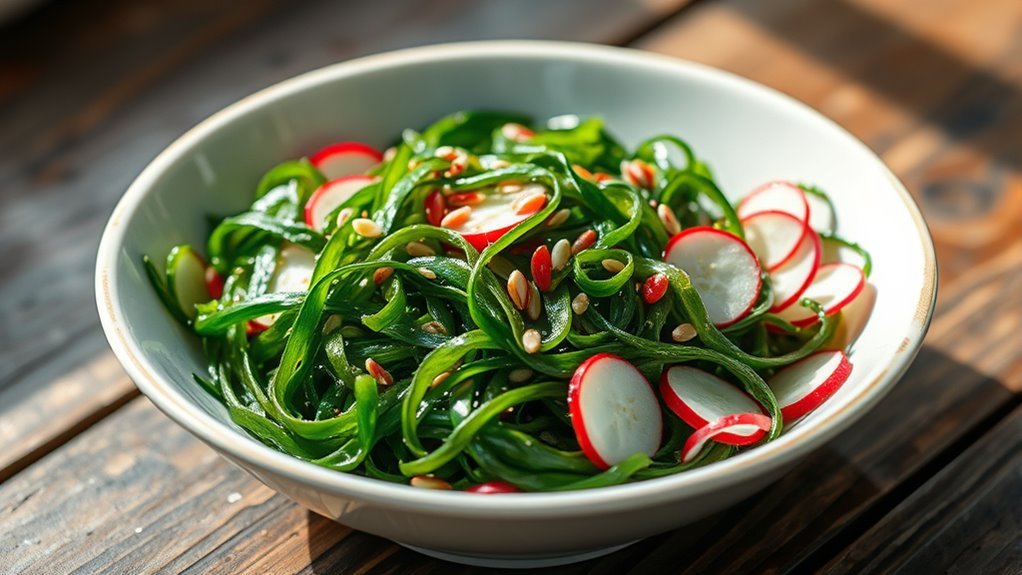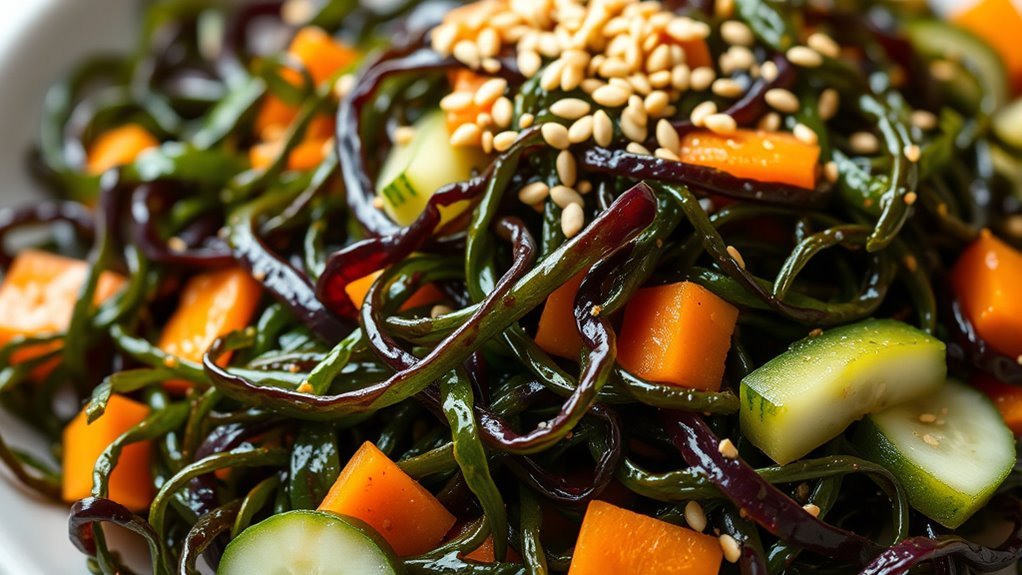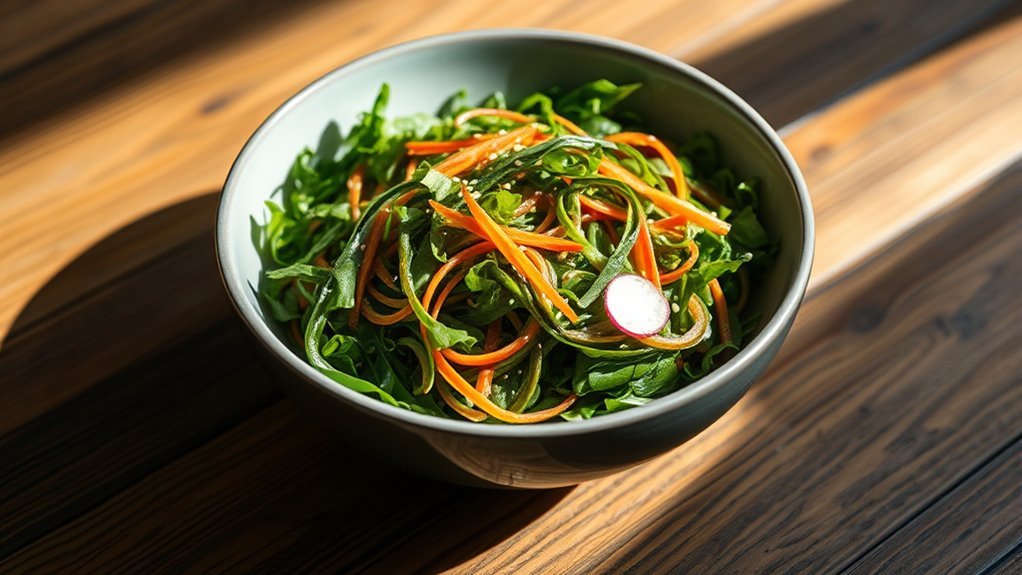Yes, seaweed salad is keto-friendly. It typically contains only 1-5 grams of carbohydrates per serving, making it a great option for low-carb diets. Packed with vitamins, minerals, and fiber, it offers various health benefits, including supporting digestion and providing antioxidants. You can enhance its nutritional profile by adding keto-friendly toppings like avocado or hard-boiled eggs. There’s plenty more to explore about how to incorporate seaweed salad into your meals for ideal flavor and health benefits.
Understanding Seaweed Salad Ingredients

When you immerse yourself in the world of seaweed salad, you’ll find a mix of ingredients that can vary considerably based on regional traditions and personal preferences. Different seaweed varieties, like wakame, nori, and dulse, offer unique flavors and textures, making each salad a distinct experience. You might prefer wakame for its tender, slightly sweet profile, while nori adds a more robust taste. Dressing options also play a vital role; tangy sesame oil, soy sauce, or rice vinegar can enhance the natural umami of the seaweed. Combining these elements allows for creativity, whether you stick to traditional Japanese recipes or add your own twist. The result is a vibrant dish that resonates with your taste and lifestyle.
Nutritional Profile of Seaweed Salad

When considering the nutritional profile of seaweed salad, you’ll find it’s low in carbs, making it a suitable option for many diets, including keto. This dish is packed with essential nutrients, offering a variety of vitamins and minerals that contribute to its overall health benefits. Additionally, the fiber content in seaweed can aid digestion and enhance satiety.
Low Carb Content
Seaweed salad is often praised for its low carbohydrate content, making it a popular choice for those following a keto diet. With minimal carbs and a variety of healthy fats, it fits well into your low carb lifestyle. Here’s a quick breakdown of its nutritional profile:
| Nutrient | Per 100g | Notes |
|---|---|---|
| Carbohydrates | 1-5g | Very low, ideal for keto |
| Healthy Fats | 1-2g | Supports energy and satiety |
| Fiber | 3-4g | Aids digestion and fullness |
Incorporating seaweed salad into your meals can help you maintain ketosis while enjoying a flavorful dish. Plus, it’s packed with minerals and antioxidants, enhancing your overall health.
Nutrient Density Overview
Beyond its low carb content, seaweed salad boasts an impressive nutrient density that makes it an important addition to any meal plan. This superfood is rich in various vitamins and minerals, enhancing your nutrient absorption and overall health. Here are three key benefits:
- Vitamin Sources: Seaweed is packed with essential vitamins like A, C, E, and K, which support immune function and skin health.
- Mineral Content: It’s a great source of iodine, crucial for thyroid function, and contains iron and calcium for bone health.
- Antioxidants: Seaweed contains antioxidants that help combat oxidative stress, promoting longevity and well-being.
Incorporating seaweed salad into your diet can provide a nutrient boost while keeping your meals exciting and flavorful!
Fiber and Minerals
Although you might not think of it, the fiber and minerals found in seaweed salad can play a significant role in your overall health. Seaweed is a fantastic source of dietary fiber, which aids digestion and helps maintain a healthy gut. Additionally, it’s packed with essential minerals that offer various health benefits.
| Nutrient | Benefits |
|---|---|
| Fiber | Aids digestion, promotes satiety |
| Iodine | Supports thyroid function |
| Calcium | Strengthens bones |
| Magnesium | Regulates muscle and nerve function |
Incorporating seaweed salad into your diet can provide these fiber sources and mineral benefits, supporting your pursuit of a healthy lifestyle while enjoying flavorful, nutrient-rich meals.
Carbohydrate Content and Keto Compatibility

When evaluating the carbohydrate content of seaweed salad, it is essential to note that this dish typically contains a low amount of carbs, making it a potentially suitable option for those following a ketogenic diet. Seaweed salad usually has about 1-5 grams of carbohydrates per serving, depending on the ingredients. Here are a few reasons why it can work well as a keto substitute:
Seaweed salad is a low-carb option, with just 1-5 grams of carbs per serving, perfect for a ketogenic diet.
- Low Carbohydrate Sources: Seaweed is primarily made of fiber and water, providing minimal carbs.
- Nutrient Density: It’s packed with vitamins and minerals, enhancing your overall nutrition.
- Versatile Ingredients: You can customize your seaweed salad with keto-friendly add-ins like avocado or sesame oil.
Incorporating seaweed salad into your meal plan may help you stay within your carb limits while enjoying delicious flavors.
Health Benefits of Seaweed in a Keto Diet
When you’re on a keto diet, incorporating seaweed can be a smart choice due to its impressive nutrient density. It’s low in carbs and high in fiber, making it an excellent addition to your meals while helping you stay within your macronutrient goals. Plus, its antioxidant properties may offer added health benefits, supporting overall well-being on your keto journey.
Nutrient Density of Seaweed
Seaweed is a powerhouse of nutrients that can enhance the health benefits of a keto diet. It’s low in calories and rich in essential vitamins and minerals, making it an excellent addition to your meals. Here are three key nutrient sources found in seaweed:
- Iodine: Vital for thyroid function and metabolism.
- Fiber: Supports digestive health and helps maintain gut balance.
- Antioxidants: Protects your cells from oxidative stress and inflammation.
Including seaweed in your keto diet not only diversifies your nutrient intake but also provides unique health benefits that support your overall well-being. By choosing nutrient-dense foods like seaweed, you empower yourself to thrive on your diet journey.
Low-Carb and High-Fiber
Although many people associate low-carb diets with limited food options, incorporating seaweed can provide a satisfying and nutritious way to stay within your carb limits while enhancing fiber intake. Seaweed is an excellent low-carb alternative, with many varieties containing minimal net carbs. This makes it a fantastic addition to your meals, helping you maintain ketosis without sacrificing flavor or texture. Additionally, seaweed is packed with fiber, which supports digestion and keeps you feeling full longer. By including seaweed in your diet, you’re not just enjoying a unique taste but also tapping into a powerful fiber source that promotes overall health. Embracing seaweed allows you the freedom to explore diverse culinary experiences while staying true to your keto goals.
Antioxidant Properties of Seaweed
While you may be focused on low-carb options in your keto diet, it’s worth noting that seaweed also offers significant antioxidant properties. These antioxidant benefits come from various seaweed compounds that can help combat oxidative stress in your body. Here are three key advantages of incorporating seaweed into your meals:
- Rich in Vitamins: Seaweed contains vitamins A, C, and E, which are known for their antioxidant effects.
- Polyphenols: These compounds found in seaweed can help reduce inflammation and improve overall health.
- Mineral Content: Seaweed is packed with minerals like zinc and selenium, essential for supporting your immune system.
How to Incorporate Seaweed Salad Into Your Meals
Incorporating seaweed salad into your meals can enhance both flavor and nutrition, making it a versatile addition to your diet. You can enjoy various seaweed types, like wakame or nori, which provide unique textures and flavors. Toss a handful of seaweed salad into your favorite stir-fry for an umami boost or serve it as a side dish with grilled proteins.
Don’t forget to experiment with different salad dressings; a simple sesame or soy-based dressing can elevate the taste. For a revitalizing twist, try a citrus vinaigrette. You can also mix seaweed salad into grain bowls or salads, adding a nutrient-rich layer without overwhelming the dish. Embrace the freedom to get creative while reaping the benefits of this nutritious ingredient!
Creative Keto-Friendly Variations of Seaweed Salad
If you’re looking to keep your meals exciting while sticking to a keto diet, you can create a variety of delicious seaweed salad variations that cater to your low-carb lifestyle. Here are some ideas to inspire your creativity:
- Creative Toppings: Add sliced avocado, toasted sesame seeds, or chopped nuts for healthy fats and crunch.
- Dressing Variations: Experiment with a sesame oil and apple cider vinegar mix or a creamy avocado-based dressing for a flavor boost.
- Protein Additions: Toss in shredded chicken, diced tofu, or shrimp to make your salad more filling and nutritious.
With these variations, you can enjoy seaweed salad while staying true to your keto goals, ensuring each meal is both satisfying and flavorful.
Frequently Asked Questions
Can I Make Seaweed Salad at Home?
Sure, you can whip up a delightful seaweed salad at home! Who needs fancy restaurants when you’ve got kitchen freedom? Grab some seaweed varieties like wakame or nori, toss in a few homemade recipes for dressing, and voilà! You’ve got an ocean of flavor right in your bowl. Just remember, balance is key—mix in some veggies and season to your liking. Enjoy your culinary adventure, and savor the sea without leaving your kitchen!
What Types of Seaweed Are Best for Salads?
When choosing types of seaweed for salads, consider nori, wakame, and dulse. Nori’s great for its high fiber content, while wakame offers essential vitamins and minerals. Dulse not only adds a unique flavor but also provides protein. Each type brings nutritional benefits, such as antioxidants and iodine, which support thyroid health. Incorporating a mix can enhance both taste and health, allowing you to enjoy a delicious, nutrient-rich salad that aligns with your dietary preferences.
Is Seaweed Salad Suitable for Gluten-Free Diets?
Yes, seaweed salad is suitable for gluten-free diets. Seaweed nutrition is rich in essential vitamins and minerals, making it a healthy alternative for those avoiding gluten. You’ll find it often paired with gluten-free ingredients like rice vinegar and sesame oil, enhancing its flavor without compromising dietary needs. If you’re looking for gluten-free alternatives, consider adding fresh veggies or gluten-free grains to your seaweed salad for added texture and nutrition. Enjoy the freedom of healthy eating!
How to Store Leftover Seaweed Salad?
To store leftover seaweed salad, it’s best to use an airtight container to maintain salad freshness. Make sure to keep it in the refrigerator, where it can last for about 3 to 5 days. If you notice any excess moisture, you might want to drain it before sealing the container. Avoid freezing seaweed salad, as it can alter the texture. Following these tips will help you enjoy your salad longer!
Are There Any Allergens in Seaweed Salad?
Like a hidden treasure, seaweed salad can be nutritious but may also harbor allergens. While it’s rich in vitamins and minerals, some individuals might have seaweed allergies, which can lead to reactions. Common symptoms include itching or swelling. If you’re unsure, it’s wise to consult with a healthcare professional before indulging. Remember, the nutritional benefits often outweigh the risks, but being cautious guarantees your culinary adventures remain delightful and worry-free.


